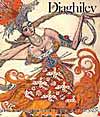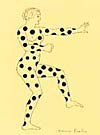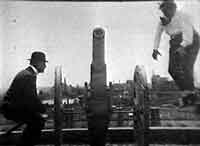|
"The musician is
perhaps the most modest of animals, but he is also the proudest. It
is he who invented the sublime art of ruining poetry." - Erik Satie
The Paris inhabited by Satie and Les Six was a Paris hungry to replace Wagnerian late-romanticism, a Paris ready for something fun. Satie and his circle were involved in seemingly everything, from composing scores for ballet and film, to acting in those films, to collaborating with poets and influencing Andre Breton's famous Surrealist Manifesto.
Perhaps most influential ballet company in Paris at the time - or any time, for that matter - was Serge Diaghilev's Ballet Russes. Its rehearsal director, Serge Grigoriev, later said, ""In the twenty years of its existence, Diaghilev's Ballets Russes accomplished more in the development of the art form than any single institution in history." Along with performing pieces scored by myriad other influential composers - Stravinsky, Debussy, and Rimsky- Korsakov among them - Ballets Russes performed several works by Poulenc, Auric, Milhaud, and Satie, most notably Satie's Parade. The 1917 premiere - the collaboration of the poet Jean Cocteau, composer Erik Satie, and Pablo Picasso - heralded a new artistic direction in Paris. The event resulted in a theater riot, critical slaughter (one concertgoer even claiming, "if I'd known it was going to be so stupid I would have brought the children."), a libel suit that resulted in Satie and Cocteau being labeled "cultural anarchists," and eight days of jail time for Satie. It also resulted in the immediate celebrity-hood of Erik Satie.
The other influential ballet troupe of the era was Ballets Suedois, which, according to the Fine Arts Museum of San Francisco, " rivaled and surpassed Diaghilev's legendary Ballets Russes in its interdisciplinary collaborations with the century's most daring visual artists, composers, writers, and musicians." Giorgio de Chirico, Jean Cocteau, and Fernand Lger were among those creating costumes, sets, books and music. Among Les Sex, Honegger and Milhaud both wrote scores for the Ballets Suidois, as did musicians as diverse as Cole Porter and Claude Debussy. In 1924 Ballet Suidois premiered Satie's ballet Relche, which would be his final piece. At the premiere, the curtain bore a sign reading: "Erik Satie is the greatest musician in the world; whoever disagrees with this notion will please leave the hall."
The nascent art form of the cinema was yet another means of expression for Satie and Les Six. Perhaps the most prominent example is Ren Claire's 1924 film Entr'acte, featuring many Dada and Surrealist artists. In the frame shown at right, Erik Satie (left) and playwright/poet Francis Picabia ignite a cannon. Entr'acte was first shown at the premiere intermission of Satie's ballet Relache and featured, among others, Satie, Man Ray, Georges Auric, Picabia, Darius Milhaud, and Marcel Duchamp. The music was by Satie; the only film score he ever wrote. However, Darius Milhaud (L'Inhumaine, Madame Bovary, many others), Arthur Honegger (La Roue, Napoleon, many others), Georges Auric (Orphe, Le Messager, many others), and Germaine Tailleferre (Torrents, others) were much more prolific in this medium, writing dozens of compositions for the cinema.
Memoirs of an Amnesiac: Satie's highly entertaining memoirs, almost so bizarre as to seem fictional. Read about his highly regimented day, his peculiar diet, and how he "cleaned" sound. Surrealist Manifesto Andr Breton's influential 1924 tract defining the role of surrealism, and the term itself: "Pure psychic automatism by which it is intended to express, either verbally or in writing, the true function of thought." (For a summary of the manifesto, read this excerpted version.) Paris Modern: From the Fine Arts Museum of San Francisco, Paris Modern: The Swedish Ballet 1920-1925 features a ballet overview, images from various productions, and an online tour. Diaghilev's Ballets Russes: A listing of the works performed by the Ballets Russes during its time in Paris, with supplementary information about many of the ballets and performers. Ballets Suidois: Maintained by the same aficionado as the previous site, this site is still a work in progress, but does feature a complete list of the works performed by this short-lived (1920-1925) yet acclaimed company. Entr'acte: This International Movie Database entry features complete cast and crew listings, links to other productions that the principals were involved in, and reviews. Selected List of Dada, Surrealist, and Avant-Garde Periodicals: Contributors to many of these journals included Satie, Eluard, Picabia, Picasso, Apollinaire, and Jacob, among others.
|
MPR Home | News | Music Collection | Events | Radio Listening | Your Voice | About Us | Support Us | Help ©2005 Minnesota Public Radio | Terms of Use | Privacy Policy |



